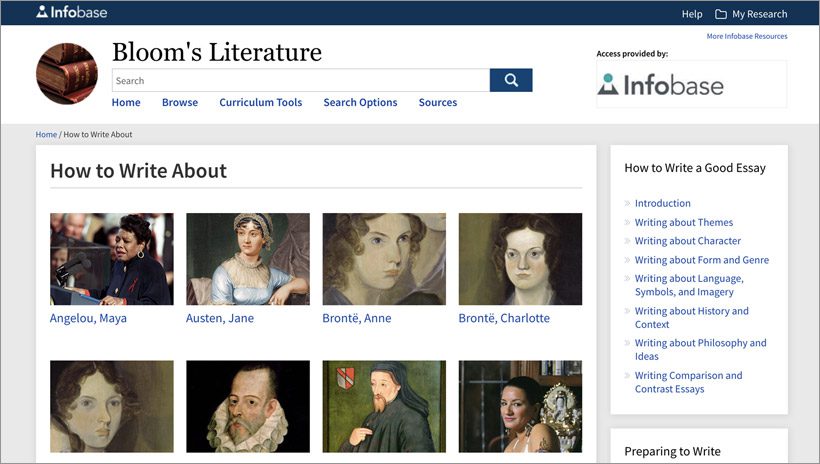Sometimes, the hardest part of writing a research paper on literature is getting started. Do you want to write about a certain work? How about themes that appear in one work, or across different works by different authors? Did the historical context of those works play any role in their creation? And, once you’ve hammered out what you want to write about…how should you even approach your topic?
Bloom’s Literature can help. The award-winning literature database has a “How to Write about Literature” feature that offers crucial, exclusive research guidance and advice for students writing essays on great literary works. Each entry they’ll find offers open-ended paper topic suggestions on a specific work or writer, as well as student-friendly advice on how to approach the topics. The entries each pose questions for student authors and suggest possibilities for things they can write about. Educators can also use the ideas found in “How to Write about Literature” to spark classroom discussions or as prompts for writing assignments.

The authors and works covered in Bloom’s “How to Write about Literature” include:
- Maya Angelou, I Know Why the Caged Bird Sings
- Jane Austen, Pride and Prejudice
- Geoffrey Chaucer, The Canterbury Tales
- Charles Dickens, Great Expectations
- Ralph Ellison, Invisible Man
- F. Scott Fitzgerald, The Great Gatsby
- Gabriel García Márquez, One Hundred Years of Solitude
- William Golding, Lord of the Flies
- Nathaniel Hawthorne, The Scarlet Letter
- Homer, The Odyssey
- Zora Neale Hurston, Their Eyes Were Watching God
- Toni Morrison, Song of Solomon
- William Shakespeare, Hamlet
- Mary Shelley, Frankenstein
- John Steinbeck, Of Mice and Men
- Mark Twain, The Adventures of Huckleberry Finn
- Oscar Wilde, The Picture of Dorian Gray
- Virginia Woolf, Mrs. Dalloway
- And many more!
Essential Writing Help
In addition to entries on specific authors and works, “How to Write about Literature” also features two sections that can be used for any writing project. The section “How to Write a Good Essay” includes easy-to-understand advice on writing papers on a variety of general topics, including writing about themes, character, form and genre, history and context, and more, plus how to write comparison and contrast essays. The “Preparing to Write” section walks readers through the different steps of putting together an essay, including preparing a thesis statement and outline; writing an introduction, conclusion, and body paragraphs; and assembling a list of works cited.
What Is Bloom’s Literature?
The award-winning Bloom’s Literature database is rich with relevant content on the core authors and works most studied in the high school curriculum. Students will find exactly what they need without having to wade through an uncurated search. Educators will appreciate the thoughtful organization and important curriculum tools to help with lesson plans, assignments, and independent study.
In addition to “How to Write about Literature,” Bloom’s also offers many other features that are ideal for students researching literature, including an Essay Topics section with thousands of additional sample topics for student essays, performance videos of classic literary works, and a Shakespeare Center that houses in one convenient location a treasure trove of content on all things Shakespeare, covering each play in depth along with the sonnets and longer poems.
Learn more about Bloom’s Literature.
See also:


